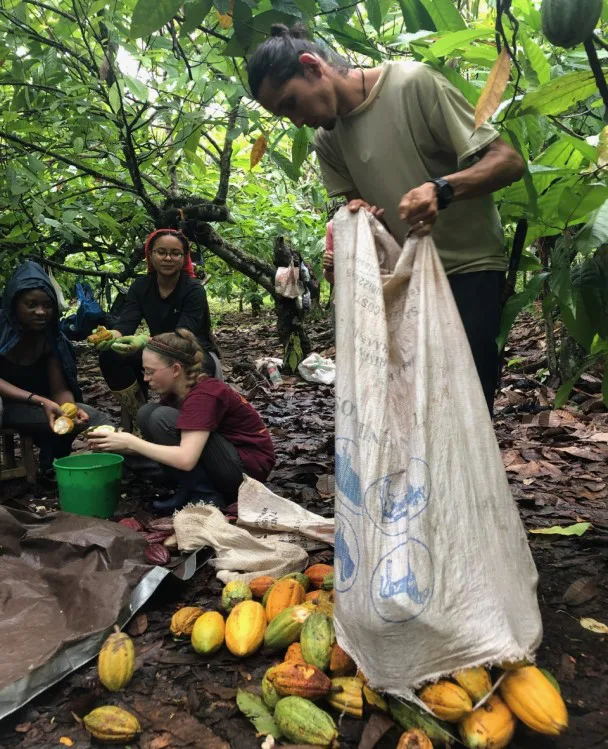Cacao’s Role in Regenerative Tourism
Our day began by hiking to the cacao plantation through hot cattle pastures scarred by erosion. The students’ relief was palpable at being embraced by the shady agroforestry system, home to poison-dart frogs, toucans, and a wild variety of insects. We got to work harvesting cacao pods and were rewarded with a break of rustic, stone ground truffles flavored with spices from the farm, appreciated as much for the energy as the incredible flavors. Farm-to-bar is the catchy phrase used to describe small batch, locally made chocolate. Harvesting, husking and hulling the cacao ourselves brought a deeper understanding of the skills, knowledge and connection to land of the people working to preserving traditional cultivation practices.


Students and professor harvesting cacao with farmer Jorge Salazar at Finca La Iguana
Food has traditional been deeply connected to place. In this globalized world, we can easily be separated from our culinary roots, that nourish us physically and culturally. We lose the memory of the local foods that grow abundantly as part of the ecosystem. We can lose sight of traditions that create delicious variety from what is locally available. Instead, it is common to become dependent on imported and processed commodities because we seek variety which we have lost track of locally.
Globalization has also made the gift of travel obtainable to many more. There are more opportunities to visit new places and landscapes to consider alternate ways of doing and being. Those experiences increasingly include the production and preparation of native foods. This semester we invited students to travel to Central America to attend our first special topic course on Chocolate and Coffee. The aim of the course is to explore the environmental and cultural legacy of these charismatic species in Costa Rica’s development. One area of focus is considering how education and agrotourism, on the rise due to globalization, can support local cultural protection while being a tool for economic growth and ecological regeneration.

Tasting traditional hot chocolate during cacao class at Tirimbina Reserve
Chocolate’s roots run deep in Latin American history as a native species that is intertwined with many Indigenous cultures’ worship and celebration. The story of chocolate also includes forced labor of Indigenous people to plant and harvest cacao and, in Costa Rica, their resistance and flight from conquest. The struggle to preserve unique genetic material, beliefs and practices related to this sacred plant continues.
As a culmination of the course, we conducted field research on cacao’s role in agrotourism. As part of the study we met with a cultural leader of the Huetares Indigenous group in central Costa Rica, working to preserve Indigenous plant knowledge, including practices related to cacao. He shared that the earth provides everything we need for life and to live well. Cacao is a prime example as it contains beneficial fats and vitamins, provides the energy boost of caffeine while stimulating endorphins to create a feeling of well-being. He is working to preserve his knowledge in a book on Indigenous uses of local plants since most Indigenous youth are interested in moving to the city for more economic opportunities instead of living locally and learning traditional practices. Tourism has become an important tool for passing on and supporting projects to preserve his group’s knowledge.

Presentation on Indigenous uses of cacao by Huetares leader Gerardo Pérez
We also experienced life with a Costa Rican family that grows and processes cacao on their farm. Their roots in this area are much newer than that of Indigenous people but their contributions to ecological preservation are deep. In the 1980s, they formed part of a cacao collective but in the 1990s the fungus Monilia (Moniliophthora roreri) blighted all of the cacao orchards in the area. They abandoned their orchards and returned to cattle ranching as their main source of income until an ecolodge and education center opened in the town in 2002. They began processing small batches of chocolate from their recovering cacao orchard themselves and selling it to visitors at the ecolodge. Interest in their chocolates was so great that they developed a tour and have grown to offer lodging for educational groups like ours. They have also enhanced their agroforestry system to include many plants for use in chocolate and more abundant food options for their family and visitors.

Collecting data on Monilia fungus infection of cacao pods at Finca La Iguana
Our field studies included evaluating the effectiveness of various Monilia control practices. Another project cataloged the local edibles and how many are incorporated into the chocolates including ginger, turmeric, passion fruit, and cinnamon. The third group evaluated the unique aspects of this agrotourism-focused community from a socioeconomic perspective. Younger members of this family shared that the agricultural and intellectual challenges of growing an agrotourism business have made staying on the farm viable and attractive to them. They also highlighted the appeal and importance of knowledge transfer generated by tourism. Many of the improvements to the chocolates and other aspects of the business have come from an exchange of ideas with tourists and volunteers. This transfer of knowledge marks the difference in tourism which drains resources and imposes demands on local culture and responsible tourism that can enrich existing practices.

Products from the farm including chocolate, cacao beans, cacao butter, and turmeric
Our study highlights the ways in which agrotourism can support multiple service providers and leaders instead of competitive north/south, neighbor-against-neighbor market models of growth. These ventures create fertile soil for preserving native species like cacao while integrating concepts from visitors. Our intensive participation in sustainable Costa Rica cacao agrotourism brings to life the possibilities of cultural and ecological regenerative agrotourism. This type of connected tourism can also travel beyond the foods of a single place to inspire our support of local, responsible production wherever in the world we call home.

Summer I students and professor Mary Little
Related Posts

Restoration on a Cinder Cone: A Syntropic Story

